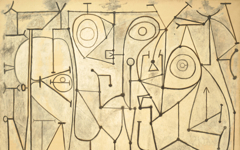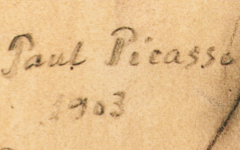Picasso’s Owl of Death (1952)

Picasso, Owl of Death or Le Hibou de la Mort (29th March 1952) Oil on canvas. Private Collection.
Click image to enlarge.
Anyone familiar from photographs with Picasso's dark, piercing eyes - even if they did not know that every painter paints himself - might instantly recognize them in this owl.
Click next thumbnail to continue

L: Picasso's Owl of Death, detail
R: Photograph of Picasso aged 15 (1896), detail.
Click image to enlarge.
When the owl's eyes are compared to an image of the artist at the age of 15, one can see their source. Even the owl's "eyebrows" are like Picasso's.
Click next thumbnail to continue

L: Picasso's Owl of Death, detail
R: Herbert List, Photograph of Picasso aged 63 (1944), detail
Click image to enlarge.
The distinctive nature of those eyes remained with Picasso throughout his life, appearing as near-caricatures in self-representations elsewhere. They were striking, in part, because almost the entire pupil was often visible, at least in photographs, just like the owl's.
Click next thumbnail to continue
However, Picasso not only gave the owl his eyes but wrote his name across its body in an even clearer sign of identification. The letters start, as they theoretically should, with the largest, a P in the wing, and then continue in the correct order up through its body until the name ends, even more significantly, with an O in the eye. Some say that you can see whatever you want in art but the chances of finding such forms in sequence - and with meaning - is probably infintessimal. The only missing letter here is a second S which he often left out.
Click next thumbnail to continue
I don't know who titled the painting or why but art's traditions - and Picasso's - leave little doubt about its true subject. We are inside Picasso's mind - behind those eyes. They are still his eyes but we see them from the other side, so to speak, in his imagination. Imagination takes flight which is probably why he began his name with the P in the wing. The owl, a facet of Picasso's mind, not only has piercing vision like all owls but is a symbol of wisdom too which is to say, inner wisdom. The latter, of course, is the sine qua non of a great artist.
More Works by Picasso
Picasso at his most abstract is still figurative in ways that have never been seen

Picasso’s The Kitchen (1948)
Notes:
Original Publication Date on EPPH: 27 Oct 2013. © Simon Abrahams. Articles on this site are the copyright of Simon Abrahams. To use copyrighted material in print or other media for purposes beyond 'fair use', you must obtain permission from the copyright owner. Websites may link to this page without permission (please do) but may not reproduce the material on their own site without crediting Simon Abrahams and EPPH.



